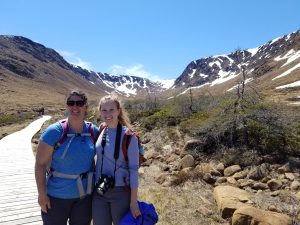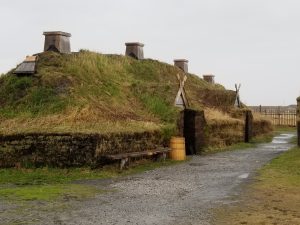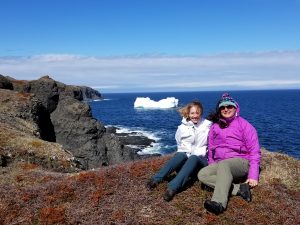Latest News
As COVID-19 cases in Massachusetts have declined, WHOI is beginning it’s phased opening plan. The institution will be open, but the campuses will still be closed and open only to those that have been approved.
NOSAMS continues to be open and to operate with a partial staff in this new re-opening phase while respecting conservative physical distancing as outlined by the Commonwealth of Massachusetts and WHOI policies. We are accepting and processing samples. NOSAMS does not expect an increase in turnaround times as a result of COVID-19. Please send questions or comments to nosams@whoi.edu.
Sophie Hage is a postgraduate research student studying Sedimentology within Ocean and Earth Science in the National Oceanography Centre at the Southampton at the University of Southampton. From March to June in 2018 she was a guest student here at the Woods Hole Oceanographic Institution working with Dr. Valier Galy. While here at WHOI working with Dr. Galy, she spent a lot of her time here at NOSAMS on the Ramped Pyrolysis and Oxidation (RPO) system.
Her recent work includes the work she did at a guest student at NOSAMS and WHOI, “Efficient preservation of young terrestrial organic carbon in sandy turbidity-current deposits”
Jon Sanderman visited the lab in 2019 to use the RPO on a series of soil profiles sampled decadally since the 1960’s. Did you know that the RPO was originally called the dirt burner? His paper is now out: Ramped thermal analysis for isolating biologically meaningful soil organic matter fractions with distinct residence times
Jessie Pearl started as a MIT/WHOI joint program student under Jeff Donnelly and Kevin Anchukaitis. Jessie worked with NOSAMS to do help develop reconnaissance radiocarbon dating- a method to get quick radiocarbon results at a lower cost and at a reduced precision- for organic carbon samples. She finished her PhD at the University of Arizona and her work on the Atlantic white cedar, A late Holocene subfossil Atlantic white cedar tree-ring chronology from the northeastern United States, is now published. Jessie is now a post doc with the USGS at their Seattle Office.
Reference: Jessie K. Pearl, Kevin J. Anchukaitis, Jeffrey P. Donnelly, Charlotte Pearson, Neil Pederson, Mary C. Lardie Gaylord, Ann P. McNichol, Edward R. Cook, George L. Zimmermann, A late Holocene subfossil Atlantic white cedar tree-ring chronology from the northeastern United States, Quaternary Science Reviews, Volume 228, 2020, 106104, ISSN 0277-3791
Beverly Barnett, a graduate student at the University of Florida, came to NOSAMS as a graduate student intern. She analyzed radiocarbon in chronological layers of fish otoliths and eye lenses to develop natural, permanent biogeochemical markers of petrocarbon in the northern Gulf of Mexico food web following the Deepwater Horizon oil spill. Her most recent work was published earlier this year: Life history of northern Gulf of Mexico Warsaw grouper Hyporthodus nigritus inferred from otolith radiocarbon analysis.
Reference: Barnett BK, Chanton JP, Ahrens R, Thornton L, Patterson WF III (2020) Life history of northern Gulf of Mexico Warsaw grouper Hyporthodus nigritus inferred from otolith radiocarbon analysis. PLOS ONE 15(1): e0228254. https://doi.org/10.1371/journal.pone.0228254
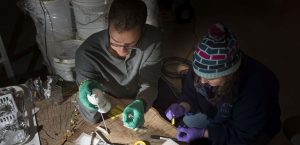
The Atlantic writer Carl Zimmer writes about the events that lead to the radiocarbon “bomb spike”, the lasting mark it has left in this world, and how scientists are studying it. The article features work from Researcher Mary Lardie Gaylord et al. and their work on radiocarbon dating tree rings on a European beech tree in Woods Hole.
Nuclear Tests Marked Life on Earth With a Radioactive Spike , By Carl Zimmer
“Even as it disappears, the “bomb spike” is revealing the ways humans have reshaped the planet.”
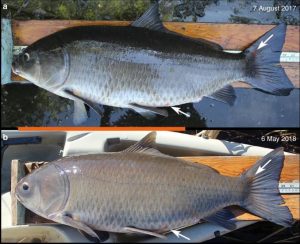 Alec Lackmann et al. report on the oldest freshwater teleosts:
Alec Lackmann et al. report on the oldest freshwater teleosts:
Scientists look to sediment cores from Caicos Island to gain insights about a monster, modern-day hurricane. Read More…
Research Assistants Lily Sanborn and Mary Lardie Gaylord joined the Geodynamics program to Newfoundland, Canada to learn more about North Atlantic Climate & Civilization. They and other students explored how changes in North Atlantic ocean circulation, considered by many as the major driver of global climate, had influenced human exploration and colonization. The study tour to Newfoundland and Labrador, Canada, (June 6 -14) taught them how the glacial geology of the landscape was shaped by melting ice sheets at the end of last ice age. The group also explored the only North American Viking settlement, a 15th century Basque Whaling site, hiked in Gros Morne National Park (a UNESCO World Heritage Site), and saw icebergs first-hand!
